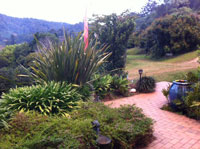

Rossmount Rural Retreat - Natural Platypus Habitat
A TALE ABOUT THE ORNITHORHYNCHUS ANATINUS – meaning ducklike animal with birdlike snout.
(As seen every day on the Australian 20cent coin).
In November 2007 Stefano, our Italian Ecoteer, armed with a magnificent new SLR camera and lens captured the following photo. He was stunned to note how aggressive the Water Dragon was chasing the platypus. We never found out because our shy platypus did a duck dive and the scene ended.

PLATYPUS CHASED BY WATER DRAGON
Rossmount boasts a magnificent lake where quiet observation can reveal the most miraculous events. We have enjoyed watching the Platypus or is it platypie for about 34 years and it never ceases to amaze us. Some general information on Platypus follows, and if you want to chill out and wait for the platypus at Rossmount Rural Retreat, we look forward to sharing our little bit of paradise with you.

PLATYPUS AVOIDS WATERDRAGON
SOME PLATYPUS FACTS
The platypus is a monotreme or egg-laying mammal. This means that a single body opening rids body waste and is used for reproduction. The platypus and two species of Echidna are the only monotremes in the world.
The platypus is dark brown on its back and generally light brown on the tummy. Under the coarse and long outer hair is a very fine, dense underfur, which is woolly. This fur can be grey to dark brown.
The platypus is endowed with a streamlined body, well adapted for swimming and appears slightly flattened. It has stout, short legs with webbed feet, which he uses to push himself through the water. The hind legs trail behind and are used as stability and steering rudders. When crossing land or making a burrow these webbed feet are under the foot. Platypus means “flat feet”
The platypus has sharp vision over long distances, but because his eyes are close to the top of his head, he cannot see anything directly under his nose. The duck like bill of the platypus is soft, sensitive and flexible organ. He uses it to search for food and navigate.
Average male platypus is 50cms long (head to tail) and weighs 1.7 kg and female platypus are about 43 cms. and weighs 900 grams, with a lifespan of 12 years. They reach maturity at 2 years of age.
The platypus is mainly a nocturnal animal. At Rossmount he is best seen during the early morning and late afternoon. Stefano took these photos late in the afternoon. Spending half his time in the water feeding, and can spend 2 – 10 minutes underwater. If he isn’t in the water the platypus is safe within his burrow.
Although the platypus is very shy, and will normally dive underwater to escape an attacker. The male platypus if unable to escape will try to attack with the spurs on his hind legs. There are hollow spurs can send enough poison to kill a dog.
The platypus usually catches his food underwater, food such as fresh water shrimps, insect larvae and adult insects. He ends of eating a great deal of mud during this, which he manages to sort and to fill his cheek pouches with the unchewed food.
Baby platypus
The platypus breeds each Spring, September through to March. Solitary animals the adults pair off as the water warms after winter. A nesting burrow can be up to 30 metres in length. The entrance to the burrow is usually above the water line (we have looked but haven’t found any entrances – as we have carefully and quietly paddled the lake)
She normally lays one to three eggs that are rubbery and about 1.5 cm in size. The mother then curls her tail over the eggs and incubates them for the next 10 – 12 days; mother platypus mainly sleeps during this time. The female normally plugs the burrow in several places to protect against marauders
When the baby platypus are hatched they are blind, but have tiny teeth, that they loose within a couple of weeks and they measure about 15mm long. The baby platypus are suckled in the burrow until they are four months old, by this time they are two thirds of their mother’s size. When they are introduced to daylight and the world they immediately begin to forage for the same food as their parents.
The predators – carpet snakes, goannas, eels, foxes and eagles.
Even though the platypus is abundant in undisturbed streams on the East Coast, canoeists, bushwalkers, nature lovers and fisherman rarely see them. It is because the platypus has a shy reserved manner, somewhat secretive and mainly nocturnal.
At Rossmount Rural Retreat you can find the experience of sighting the platypus extremely rewarding, sitting in a quite relaxed position on a perfectly still early morning or late afternoon, watching the reflections and waiting for the tell tale sign of bubbles on the surface of the water, then following his path and he forages for insects. Still wonder what the Water dragon was going to do when he caught him.


